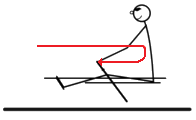|
|
The rowing stroke (J-stroke) |
Why rowing technique? Rowing technique (performing the correct movement) is important to achieve the following goals.
- Preventing injuries.
- Rowing together and synchronized with other teammates.
- Convert the power delivered by the rower(s) optimally into speed (i.e. 'free' speed). Unlike cycling, for example, in rowing it matters how and when the power is applied. Good timing and power distribution thereby ensure more return on the invested power.
- Reduce the risks of catching a crab, especially when waves occur.
- Rowing mindfully. We all row for fun and then it helps to be in the boat in the here and now. And so not thinking about the problems at study or work, the miserable action list or the hassle with the kids at school. You can do this by searching for the ideal fetch, because that search never gets boring and keeps you in the here and now.
The proper rowing stroke - called J-stroke for didactic reasons - is the preferred rowing stroke recommended by this app. The J-stroke is performed in one continuous motion from catch up to (and including) initial away. The point where the draw ends (and pauses), on ¼ seat, is called the rest point. The rest point may have a little pause or hesitation in the continuity of the stroke. A stroke performed with this rest point in mind looks like a lying J, (![]() ) hence the name.
) hence the name.

The Australian stroke - with the distinctive stop after the finish - is a stroke that is not suitable for the majority of rowers. The reasons for this are the following:
- the variant with a stop direct after the finish (
 pause 1) causes problems with high waves;
pause 1) causes problems with high waves; - this stroke only pays off at a very high boat speed and an extremely direct catch;
- the stroke is extremely complex to perform and therefore only suitable for very advanced race rowers;
- with a wrong execution seconds are lost, with a correct execution tenths of seconds are gained.
The J-stroke is described in the following paragraphs.
 |
Hands |
 |
Recovery |
 |
Catch |
 |
Draw |
 |
Finish |
 |
Balance |
 |
Stroke rate |
 |
Rhythm |











